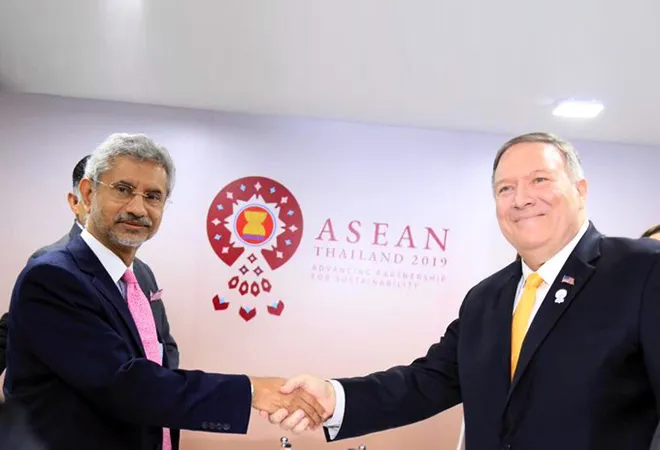
The US-India commercial relationship – trade and investment – has been growing steadily over the years and seems destined for an exciting, even transformational, future. However, both sides – meaning the two governments -- have been stuck for decades in a continuous feedback loop of neglect, occasionally interrupted by moments of high tension and conflict, when it comes to the trade relationship.
In the WTO, the United States and India have generally seen each other as leaders of factions that are interminably locked in a battle for the future of the multilateral system. That dynamic is akin to a modern-day War of the Roses, and it seems likely that it will continue to boil over before a new era replaces it, just as the Tudors finally brought Lancaster and York together in 15th century England.
In the WTO, the United States and India have generally seen each other as leaders of factions that are interminably locked in a battle for the future of the multilateral system
The bilateral trade relationship has been only marginally better. For many years, neither side paid much attention to building it up in positive ways. Most of the engagement involved periodic meetings to talk past each other on problems in the other’s markets, with occasional annual ministerial statements that generally papered over the differences.
This longstanding dynamic has stood in stark contrast to the burgeoning strategic relationship over the last two decades, extending back to the Clinton and George W. Bush administrations. Many have advocated that the strategic relationship should dictate the trade one, but those views tend to minimize the value and importance of building a robust trade relationship that can stand on its own. It is clear that the trade relationship should never trump the strategic one but neither should the strategic trump the trade one. Both require attention and strong efforts at nurturing on independent, but mutually supportive, grounds. Before the Donald R. Trump administration took office, there were plenty of longstanding examples of that – for the United States, that included the EU, Japan, Korea, Canada, etc. The list goes on and on.
Now the two sides are truly at a crossroads on trade. Tensions have reached unprecedented levels, as each side has imposed measures that have directly impacted the commercial interests of the other. Each has engaged in protectionist actions that have provided impetus to voices that counsel that no quarter be given – action requires counter-action. Down one road is a destination of further conflict, with no clear end in sight. Down the other, however, there could be the promise of agreement that can offer a new era of mutual attention and collaboration.
That road of promise may not seem so obvious – conflict appears to be the more solid bet – but it is real nonetheless. What would it require? The formula is not an easy one, but it certainly could be attainable. It should include:
- Manage Current Tensions: This is obvious and urgent. The current situation of US suspension of India’s generalized system of preferences (GSP) benefits and Indian retaliation against US tariffs on steel and aluminum could escalate into a broader trade war if the United States launches a Section 301 review. An agreement now on central elements is no easy thing but doable if each side approaches re-engagement with a spirit of creativity and compromise.
- Improve Institutional Underpinnings: The two central players – the US Trade Representative (USTR) and the Ministry of Commerce and Industry (MOCI) – must be empowered to fix problems through direction from leaders and the ability to coordinate among interested ministries and departments. This is more challenging on the Indian side, given that trade officials cycle in and out every few years. An ideal scenario might involve India establishing a trade entity with a more permanent career staff of trade negotiators, similar to USTR and parallel offices in other countries (e.g., DG Trade for the EU).
- Recommit to the Trade Policy Forum (TPF): Trade should not be subsumed in existing strategic dialogues, as some have suggested. This would only compound current problems. The TPF, if it were to meet more frequently at ministerial and other senior levels and if trade officials were empowered to negotiate in true give-and-take dynamics, has the potential to succeed in the future.
- Build on Past Cooperative Successes: Trade officials have succeeded in recent years in cooperating on implementation of the WTO Trade Facilitation Agreement (TFA), despite being at loggerheads when negotiations on that agreement concluded in Bali in 2013. This model could be replicated in other areas, such as intellectual property rights, digital trade, and regulatory cooperation.
- Explore Opportunities for Market Opening Agreements: This proposition is easier said than done, but is within the realm of possibilities in coming years if progress is made on the fronts identified above. Once immediate tensions are calmed, negotiating teams are empowered, ministers are meeting on a more regular and sustained basis, and collaborative efforts bear fruit, the United States and India might find opportunities for negotiating market access agreements, short of a free trade agreement (FTA). Options might include government procurement, regulatory recognition agreements, or trade-in services.
- Look to the Future – a US-India FTA: At this moment, the idea of an FTA seems far-fetched. And it is any time soon. But an FTA is near to the ultimate form of economic integration, and the United States and Indian relationship is likely to be the most consequential in the 21st If they can build confidence and rapport on trade matters in the next several years, there might come a moment when the compelling arguments in favor of an FTA outweigh the very real ones against. An undertaking as fraught and complicated as an FTA negotiation should not be entered into lightly or too quickly. Yet this relationship deserves some high level of aspirations – even dreaming.
For more on this issue, see the joint Atlantic Council – US-India Strategic Partnership Forum report, “Trade at a Crossroads: A Vision for the U.S.-India Trade Relationship”
The views expressed above belong to the author(s). ORF research and analyses now available on Telegram! Click here to access our curated content — blogs, longforms and interviews.



 The US-India commercial relationship – trade and investment – has been growing steadily over the years and seems destined for an exciting, even transformational, future. However, both sides – meaning the two governments -- have been stuck for decades in a continuous feedback loop of neglect, occasionally interrupted by moments of high tension and conflict, when it comes to the trade relationship.
In the WTO, the United States and India have generally seen each other as leaders of factions that are interminably locked in a battle for the future of the multilateral system. That dynamic is akin to a modern-day War of the Roses, and it seems likely that it will continue to boil over before a new era replaces it, just as the Tudors finally brought Lancaster and York together in 15th century England.
The US-India commercial relationship – trade and investment – has been growing steadily over the years and seems destined for an exciting, even transformational, future. However, both sides – meaning the two governments -- have been stuck for decades in a continuous feedback loop of neglect, occasionally interrupted by moments of high tension and conflict, when it comes to the trade relationship.
In the WTO, the United States and India have generally seen each other as leaders of factions that are interminably locked in a battle for the future of the multilateral system. That dynamic is akin to a modern-day War of the Roses, and it seems likely that it will continue to boil over before a new era replaces it, just as the Tudors finally brought Lancaster and York together in 15th century England.
 PREV
PREV


